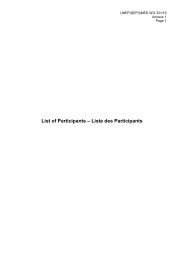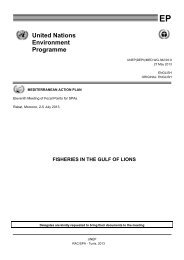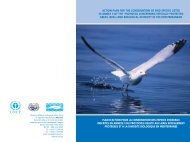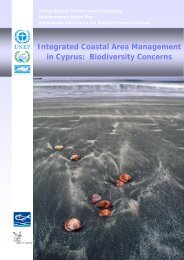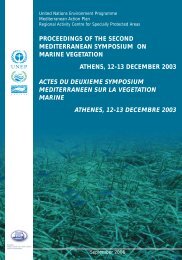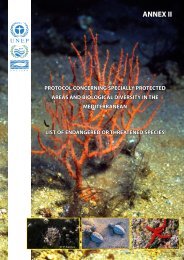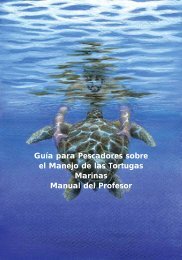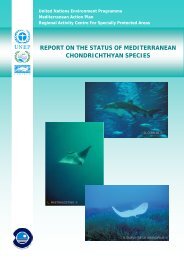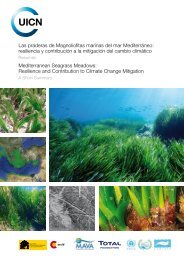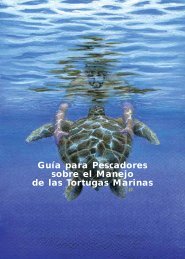assess it and monitor it? by Prof. J.G HARMELIN - Regional Activity ...
assess it and monitor it? by Prof. J.G HARMELIN - Regional Activity ...
assess it and monitor it? by Prof. J.G HARMELIN - Regional Activity ...
You also want an ePaper? Increase the reach of your titles
YUMPU automatically turns print PDFs into web optimized ePapers that Google loves.
LE CORALLIGENE, UN PATRIMOINE EXCEPTIONNEL :<br />
COMMENT L’EVALUER ET LE SURVEILLER ?<br />
J.G. Harmelin, Tabarka, 01 2009
THE CORALLIGENOUS COMMUNITY,<br />
AN EXCEPTIONAL HERITAGE:<br />
HOW TO EVALUATE AND TO MONITOR IT?<br />
J.G. Harmelin, Tabarka, 01 2009
Why y this her<strong>it</strong>age g is so remarkable?<br />
- Biodivers<strong>it</strong>y hot-spot: local species richness > 600 esp.,<br />
about 1700 species recorded (Ballesteros (Ballesteros, 2006). 2006)<br />
- Construction of huge bioherms.<br />
- Structural importance of long-lived species w<strong>it</strong>h weak<br />
population dynamics (slow growth, sporadic recru<strong>it</strong>ment).<br />
- Occurrence of rare, vulnerable species.<br />
- Occurrence of species w<strong>it</strong>h very high commercial value value.<br />
- Exceptional aesthetic value of the coralligenous<br />
scenery scenery, shaped <strong>by</strong> sessile <strong>and</strong> mobile species species.
But the coralligenous her<strong>it</strong>age is impacted<br />
But the coralligenous her<strong>it</strong>age is impacted<br />
<strong>by</strong> many sources of alteration
Pollution Facies of L<strong>it</strong>hophyllum incrustans at 400 m<br />
from the Marseille’s sewer outlet<br />
- Increase of turbid<strong>it</strong>y & silting +<br />
chemical pollutants<br />
• Exclusion of sensible species species,<br />
proliferation <strong>and</strong> monopolization<br />
of hab<strong>it</strong>at <strong>by</strong> opportunistic species<br />
Gulf of Fos, 21 m: industrial area<br />
+ harbour + Rhône river<br />
at 3000 m from the<br />
same sewer outlet
Fishing gears<br />
Physical damages in<br />
hi highly hl ffrequented t d s<strong>it</strong>es <strong>it</strong><br />
Divers<br />
This<br />
Paramuricea was<br />
probably<br />
50 yrs old!<br />
Anchors
Invasive algae<br />
Port-Cros, Galère,<br />
34m, 06/2003<br />
Port-Cros,<br />
Gabinière Gabinière,<br />
33m, 08/2004<br />
Port-Cros, Gabinière 30m, 09/2007<br />
Filamentous<br />
algae g<br />
Exotic Caulerpa racemosa cylindracea
Paramuricea clavata<br />
Pos<strong>it</strong>ive thermal anomalies<br />
1999, 2003: mortal<strong>it</strong>y of many invertebrate<br />
species<br />
Spongia officinalis<br />
Pentapora fascialis
Excessive fishing
The coralligenous hab<strong>it</strong>at is particularly vulnerable<br />
<strong>and</strong> thus needs a particular attention<br />
Two main objectives:<br />
- evaluation of <strong>it</strong>s cond<strong>it</strong>ion, at various spatial scales;<br />
- characterization of changes occurring in s<strong>it</strong>es.<br />
Great need for :<br />
(1) reliable <strong>and</strong> easily perceptible cr<strong>it</strong>eria of good health<br />
of the coralligenous assemblages,<br />
(2) methods of <strong>assess</strong>ment <strong>and</strong> mon<strong>it</strong>oring easy to<br />
(2) methods of <strong>assess</strong>ment <strong>and</strong> mon<strong>it</strong>oring easy to<br />
operate
Same objectives as for the other Med<strong>it</strong>erranean icon:<br />
the Posidonia oceanica beds<br />
• 1 single founding species, species<br />
photosynthetic & infral<strong>it</strong>toral<br />
• lim<strong>it</strong>ed vertical distribution,<br />
• cr<strong>it</strong>eria of qual<strong>it</strong>y simple<br />
<strong>and</strong> quantifiable
Coralligenous<br />
assemblages form a<br />
much more complex,<br />
multiform system!<br />
• formed o ed <strong>by</strong> multiple u t p e<br />
engineer species, often<br />
patchtly p y distributed, ,
Coralligenous assemblages form a much more complex, multiform system!<br />
Coralligenous bioherm: the true<br />
coralligenous hab<strong>it</strong>at fide Laubier<br />
(1966), Ballesteros (2006), <strong>and</strong> al.,<br />
… or a particular p facies among g the<br />
coralligenous assemblages<br />
• Contrast between bioherms<br />
bbuilt ilt <strong>by</strong> b Corallinacae<br />
<strong>and</strong> rocky walls dominated <strong>by</strong><br />
llarge suspension-feeder i f d<br />
invertebrates
Coralligenous assemblages form<br />
a much more complex, multiform<br />
system!<br />
• integrates intimately<br />
many commun<strong>it</strong>ies, from<br />
algae assemblages to<br />
cave commun<strong>it</strong>ies
Coralligenous assemblages form a much more complex, multiform system!<br />
North-Western Med<strong>it</strong>erranean<br />
(F (France, Port-Cros, P t C 44 44m)<br />
)<br />
• presents a wide geographic variabil<strong>it</strong>y<br />
Eastern Med<strong>it</strong>erranean (Turkey, Kas, 45m)
Coralligenous assemblages form a much more complex, multiform system!<br />
• distributed over a vast vertical range<br />
in the Circal<strong>it</strong>toral zone.<br />
15 m 65 m<br />
> 100 m<br />
lim<strong>it</strong>ed accessibil<strong>it</strong>y<br />
+ high survey costs
Biodivers<strong>it</strong>y is the<br />
fundamental qual<strong>it</strong>y<br />
of the coralligenous<br />
hab<strong>it</strong>at<br />
How to qualify <strong>and</strong> to<br />
quantify this divers<strong>it</strong>y at<br />
different geographic<br />
scales?<br />
How to mon<strong>it</strong>or temporal<br />
changes in divers<strong>it</strong>y ?<br />
Through inventories covering<br />
all groups? A considerable work which<br />
• Laubier (1966): 544 invertebrates, needs destructive sampling <strong>and</strong><br />
• Hong (1980): 682 species an armada of taxonomists,<br />
• Ros et al.: 497 species <strong>and</strong> information obtained is local
Necess<strong>it</strong>y to focus<br />
on particular large<br />
species, or lim<strong>it</strong>ed<br />
assemblages<br />
3 approaches<br />
1 - Visual censuses <strong>and</strong><br />
direct measurements<br />
Particular species or small assemblages<br />
Some targets:<br />
large perennial algae<br />
scleractinians<br />
gorgonians<br />
large erect bryozoans<br />
large crustaceans<br />
large echinoderms<br />
fish<br />
2 - Photographic &<br />
video id recordings di<br />
Larger assemblages<br />
3 - In s<strong>it</strong>u experiments<br />
ee.g., g colonisation <strong>by</strong> cryptic<br />
bryozoans;<br />
divers<strong>it</strong>y <strong>and</strong> activ<strong>it</strong>y of bioeroders
Necess<strong>it</strong>y to focus on particular large species, or lim<strong>it</strong>ed assemblages<br />
1 - Visual censuses <strong>and</strong><br />
direct measurements<br />
Particular species or small assemblages<br />
Examples of targets:<br />
1.1 - gorgonians<br />
1.2 - large erect bryozoans<br />
1.3 - fish
1.1 - Assessment of the cond<strong>it</strong>ion of<br />
gorgonian populations<br />
• Size measurements<br />
( ( demographic<br />
structure, biomass)<br />
• Dens<strong>it</strong>y of population<br />
+<br />
• Rate of necrosis<br />
• Fouling stage
1998 1999<br />
Pérèz et al., unpublished<br />
Mon<strong>it</strong>oring of Paramuricea clavata populations<br />
affected <strong>by</strong> mortal<strong>it</strong>y events<br />
A<br />
B<br />
Permanent plot before (A) <strong>and</strong> after (B) the mass<br />
mortal<strong>it</strong>y at la Gabinière, Port-Cros in 1999<br />
Linares et al. (2008)<br />
18 quadrats (2 m²)<br />
1992<br />
La Galère, 22-30m<br />
P. clavata<br />
Biomass<br />
2004<br />
Harmelin & Garrabou, 2005<br />
Dens<strong>it</strong>y (N colonies/m²): changes<br />
between 1999 <strong>and</strong> 2007
1.2 - Large erect bryozoans as indicators of<br />
healthy coralligenous hab<strong>it</strong>at<br />
Adeonella calveti Sm<strong>it</strong>tina cervicornis Pentapora fascialis Turbicellepora avicularis<br />
Myriapora truncata Reteporella grimaldii<br />
Distribution of 6 large erect bryozoans in<br />
g y<br />
coralligenous bottoms subjected to<br />
pollution gradients
1.2 - Large erect bryozoans as indicators of<br />
healthy coralligenous hab<strong>it</strong>at<br />
Adeonella calveti Sm<strong>it</strong>tina cervicornis Pentapora fascialis Turbicellepora avicularis<br />
Myriapora truncata Reteporella grimaldii<br />
Average N of species <strong>and</strong> colonies in<br />
0.25 m² quadrats
Fish as indicators of global change <strong>and</strong> protection in coralligenous bottoms:<br />
1.3 - Censuses of the dusky grouper population in the National Park of Port-Cros<br />
120 N<br />
100<br />
80<br />
60<br />
40<br />
20<br />
0<br />
Coralligenous s<strong>it</strong>es<br />
10-155<br />
20-255<br />
30-355<br />
Port-Cros, October 2008<br />
Demographic structure<br />
40-455<br />
50-555<br />
60-655<br />
70-755<br />
80-855<br />
Total length (cm)<br />
90-955<br />
100-1055<br />
110-1155<br />
120-1255<br />
450<br />
N<br />
400 Sh Shallow ll s<strong>it</strong>es <strong>it</strong><br />
350<br />
300<br />
250<br />
200<br />
150<br />
100<br />
50<br />
0<br />
Coralligenous s<strong>it</strong>es<br />
1993 1996 1999 2002 2005 2008
Necess<strong>it</strong>y to focus on particular large species, or lim<strong>it</strong>ed assemblages<br />
2 - Photographic &<br />
video recordings<br />
Examples:<br />
2.1 - red coral<br />
22- 2.2 - plurispecific assemblages<br />
associated to Paramuricea<br />
2.3 - invasion of coralligenous<br />
assemblages <strong>by</strong> Caulerpa racemosa
2.1 - Assessment of the status of the local red coral populations:<br />
Size of colonies<br />
Not protected: Marseille<br />
PProtected: t t d SSc<strong>and</strong>ola d l<br />
Old method: direct measurements<br />
New method: photogrammetry.<br />
Measurements obtained <strong>by</strong> y image g<br />
analyses<br />
O. Bianchimani, 2005<br />
R. Graille, 2007
Approach 2: Photographic recordings<br />
Medchange<br />
Objectif 3<br />
Aspects écologiques<br />
2.2 - Long-term analyses of the commun<strong>it</strong>y<br />
dynamics: photographic series <strong>by</strong> J. Garrabou<br />
Medes (Catalonia)<br />
series: since 1993<br />
Riou (Marseille)<br />
series: since 2000<br />
Joachim Garrabou Núria TEIXIDÓ<br />
Joachim Garrabou, Núria TEIXIDÓ,<br />
Eva MÁRQUEZ I CANALS
Medchange<br />
Objectif 3<br />
Aspects écologiques<br />
2.2 - Characterization of macrospecies biodivers<strong>it</strong>y<br />
in two gorgonian commun<strong>it</strong>ies
Objectif 3<br />
Caractérisation de la biodivers<strong>it</strong>é des communautés de<br />
Paramuricea clavata<br />
3 local<strong>it</strong>ies<br />
Photo-quadrats (25 x 25<br />
cm) w<strong>it</strong>hin permanent<br />
plots in the P. clavata<br />
commun<strong>it</strong>y<br />
Identification of species w<strong>it</strong>hin the photo-quadrats,<br />
+ if needed, d d verification ifi ti w<strong>it</strong>h <strong>it</strong>h mini-samples.<br />
i i l
Objectif 3<br />
Caractérisation de la biodivers<strong>it</strong>é des communautés de Paramuricea clavata<br />
Premiers résultats<br />
22 bryozoaires<br />
Nombre de taxons:<br />
7 algues<br />
7 tuniciers<br />
10 cnidaires 3 polychètes<br />
39 éponges<br />
1f 1 foraminifère i ifè
Objectif 3<br />
Caractérisation de la biodivers<strong>it</strong>é des communautés de 2<br />
gorgonaires Quadrats de P. clavata<br />
Sc<strong>and</strong>ola Marseille Mèdes<br />
S<strong>it</strong> S<strong>it</strong>es SPA SPL SGL PGP PCO MME MPT MRB<br />
Nombre<br />
d’espèces pour<br />
une même<br />
surface<br />
65 54 63 67 57 59 50 60<br />
Cnidaires (sur<br />
10) 8 6 5 8 5 6 7 6<br />
Bryozoaires (sur<br />
21) 16 12 14 15 14 12 11 10<br />
E Eponges (sur ( 42)<br />
23 19 26 28 25 26 22 28<br />
Total des espèces<br />
suivies 97
Objectif 3<br />
Caractérisation de la biodivers<strong>it</strong>é des communautés de Paramuricea clavata<br />
Premiers résultats<br />
% Occurrence of taxa on 1m2 quadrats: geographic variabil<strong>it</strong>y of the<br />
commun<strong>it</strong>y compos<strong>it</strong>ion<br />
• Clear differences between<br />
regions: Corsica # Marseille<br />
#M # Medes d<br />
• Differences w<strong>it</strong>hin regions<br />
<strong>and</strong> w<strong>it</strong>hin s<strong>it</strong>es are also<br />
sometimes well marked:<br />
1. S<strong>it</strong>e de Pallazinu très<br />
différent des autres<br />
2. Gr<strong>and</strong>e différence entre les<br />
deux quadrats du s<strong>it</strong>e de la<br />
Grotte Pérès
Marseille, Riou Is., 35 m<br />
Remark on inter-s<strong>it</strong>es<br />
differences<br />
The occurrence of a particular<br />
species may be informative,<br />
not <strong>it</strong>s lack, except if proved that<br />
<strong>it</strong> was formerly yp<br />
present<br />
Port-Cros national Park,<br />
Gabiniere Is., 35 m<br />
Red coral: common at Marseille<br />
is naturally absent at Port-Cros<br />
= 0
2.3 - Mon<strong>it</strong>oring of the colonization of the coralligenous bottoms <strong>by</strong><br />
Caulerpa racemosa cylindracea at Port-Cros (GIS Posidonie, 2008)<br />
Impact p on the assemblages g of deep-water p Cystoseira y spp. pp <strong>and</strong> Corallinacae<br />
Study <strong>by</strong> photo-quadrats<br />
<strong>and</strong> image g analyses, y , <strong>and</strong><br />
in s<strong>it</strong>u measurements of<br />
the Cystoseira population<br />
parameters
Necess<strong>it</strong>y to focus on particular large species, or lim<strong>it</strong>ed assemblages<br />
3 - In s<strong>it</strong>u experiments<br />
Examples:<br />
3.1 - colonisation <strong>by</strong> cryptic bryozoans<br />
32- 3.2 - divers<strong>it</strong>y <strong>and</strong> activ<strong>it</strong>y of bioeroders
Assessment of the coralligenous species richness through the<br />
study of colonisation <strong>by</strong> cryptic bryozoans<br />
Why?<br />
• Cav<strong>it</strong>ies of the coralligenous<br />
bioherm are occupied <strong>by</strong> rich<br />
assemblages dominated <strong>by</strong><br />
bryozoans<br />
• This part of the coralligenous<br />
biodivers<strong>it</strong>y is poorly accessible<br />
<strong>and</strong> st<strong>and</strong>ardization of sampling<br />
is not easy<br />
• Dispersal of larvae produced<br />
<strong>by</strong> cryptic bryozoans is very<br />
lim<strong>it</strong>ed<br />
recru<strong>it</strong>ment mirrors the<br />
recru<strong>it</strong>ment mirrors the<br />
local assemblage
3.1 - In s<strong>it</strong>u experiments : colonisation <strong>by</strong> cryptic bryozoans<br />
altered<br />
s<strong>it</strong>es i<br />
« normal »<br />
s<strong>it</strong>es<br />
Cyclostomes<br />
are good d<br />
indicators<br />
from Harmelin & Capo (2002)
3.2 - In s<strong>it</strong>u experiments : divers<strong>it</strong>y <strong>and</strong> activ<strong>it</strong>y of bioeroders<br />
Wh Why? ?<br />
• Bioerosion increases in altered coralligenous s<strong>it</strong>es<br />
(Hong (Hong, 1980)<br />
• This part of the coralligenous assemblage is poorly<br />
accessible <strong>and</strong> st<strong>and</strong>ardization of sampling is not<br />
easy<br />
Experimental colonization<br />
of st<strong>and</strong>ardized blocks of<br />
coralligenous concretion<br />
may provide information<br />
about the environmental<br />
status of s<strong>it</strong>es (cf. poster <strong>by</strong> S.<br />
Sartoretto Sa to etto et a al.) )
Concluding remarks<br />
• The complex<strong>it</strong>y <strong>and</strong> multiplic<strong>it</strong>y of aspects of the coralligenous<br />
bottoms imply multiple mon<strong>it</strong>oring targets <strong>and</strong> the use of various<br />
methods.<br />
• Changes in the status of some flagship species of the<br />
coralligenous assemblages bring obvious indications.<br />
• HHowever, a systemic t i approach h would ld bbe ddesired i d ffor evaluating l ti<br />
the coralligenous s<strong>it</strong>es.<br />
A methodology using a panel of bioindicators <strong>and</strong> physical<br />
parameters p should be conceived for the coralligenous g<br />
assemblages, such as CARLIT methodology for l<strong>it</strong>toral <strong>and</strong><br />
upper-subl<strong>it</strong>toral upper subl<strong>it</strong>toral commun<strong>it</strong>ies (Ballesteros et al., 2007).
1966<br />
1996<br />
Last remark from an old diver<br />
(<strong>and</strong> photographer)<br />
We need to store carefully<br />
the memory y of the ppresent<br />
UW l<strong>and</strong>scapes!<br />
Unfortunately, y we have already y lost a<br />
considerable amount of information on<br />
the evolution of the physiognomy of<br />
s<strong>it</strong>es during the last fifty years, a<br />
crucial period!
Somewhere in Provence,<br />
40m, during the sixties,<br />
but where exactly?<br />
And now, how is this<br />
l<strong>and</strong>scape?<br />
after repeated impacts of<br />
anchors, nets, thous<strong>and</strong>s of<br />
We need to store carefully<br />
the memory of the present<br />
UW l<strong>and</strong>scapes!<br />
It is time now to use the<br />
proper tools to map precisely<br />
series of reference s<strong>it</strong>es in<br />
every y region, g , <strong>and</strong> to ppicture<br />
them precisely at different<br />
l<strong>and</strong>scape? spatial scales scales.<br />
divers divers, temperature<br />
anomalies, <strong>and</strong> invasive<br />
algae?
THANK YOU FOR YOUR ATTENTION



